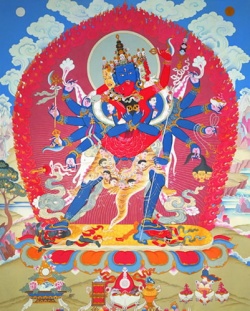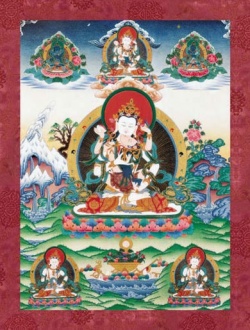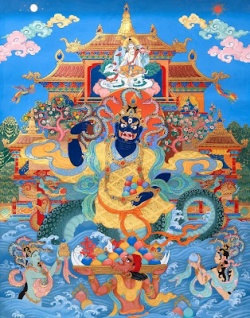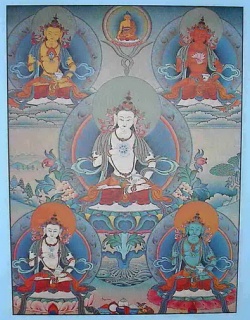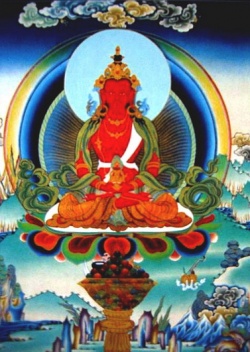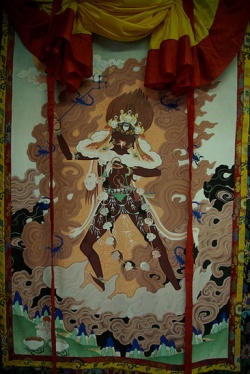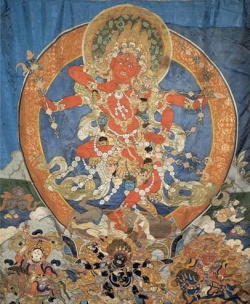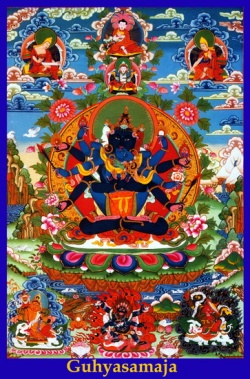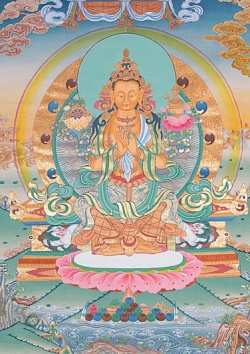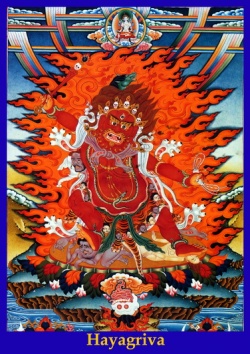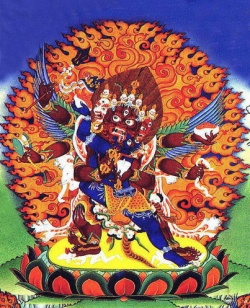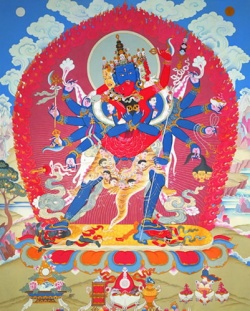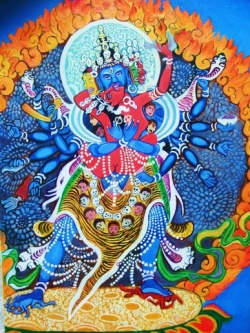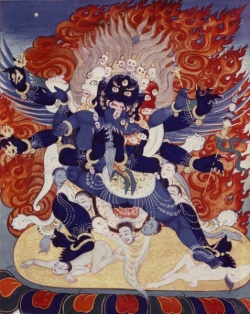The Enhancement of Visuospatial Processing Efficiency Through Buddhist Deity Meditation
ABSTRACT—This study examined the effects of meditation on mental imagery, evaluating Buddhist monks’ reports concerning their extraordinary imagery skills. Practitioners of Buddhist meditation were divided into two groups according to their preferred meditation style: Deity Yoga (focused attention on an internal visual image) or Open Presence (evenly distributed attention, not directed to any particular object). Both groups of meditators completed computerized mental-imagery tasks before and after meditation. Their performance was compared with that of control groups, who either rested or performed other visuospatial tasks between testing sessions. The results indicate that all the groups performed at the same baseline level, but after meditation, Deity Yoga practitioners demonstrated a dramatic increase in performance on imagery tasks compared with the other groups. The results suggest that Deity meditation specifically trains one’s capacity to access heightened visuospatial processing resources, rather than generally improving visuospatial imagery abilities.
Tibetan Buddhist meditative techniques are thought to enhance not only overall mental functioning, but also specific cognitive processes such as attention, perception, or mental imagery (Goleman, 1977; Wangyal, 1993). According to prominent Buddhist scholars (e.g., the Dalai Lama’s and Matthieu Ricard’s quotes from the 2003 Investigating the Mind meeting, cited in Barinaga, 2003), there are accomplished Buddhist practitioners who have developed exceptional imagery skills to the extent that they are able to maintain complex religious images in visuospatial working memory for minutes, sometimes hours, without noticeable degradation. During the Investigating the Mind Conference at the Massachusetts Institute of Technology in 2003, Buddhist monks andWestern scientists engaged in lively exchanges concerning the credibility of such claims. According to the psychological view on imagery (e.g., Kosslyn, 1994), maintaining an image for such a long time is impossible, as images fade in a matter of seconds because of the limited capacity of working memory resources.
The main goal of this study was to investigate the effects of different styles of Buddhist meditation on such imagery abilities as dynamic manipulation of spatial information and maintenance of a complex image in visuospatial working memory. The claims of Buddhist monks regarding their exceptional capacity for visuospatial memory, if true, would radically change current theories of mental imagery and have profound practical implications. There has been evidence indicating that it is possible to improve individual performance on higher-order spatialimagery tasks that require dynamic manipulation of stimuli (e.g., mental rotation) by playing action video games (e.g., Feng, Spencer, & Pratt, 2007) or by manipulating a variety of spatial stimuli (e.g., Kozhevnikov & Thornton, 2006). However, the extent to which maintenance of a static image in visuospatial working memory can be enhanced is largely unknown. Several neuroimaging studies have found that repeated practice leads to changes in brain activation in the areas involved in performing visuospatial working memory tasks (e.g., ventral and dorsal frontal regions), and such results suggest training-induced plasticity (e.g., Sayala, Sala, & Courtney, 2005). These changes, however, occurred mostly for tasks related to maintenance of information about an object’s spatial location, rather than tasks related to maintenance of information about an object’s visual appearance. Other studies on the enhancement of image maintenance have primarily been limited to pharmacological manipulations, such as dopaminergic modulation of working memory (Luciana, Deue, Arbisi, & Leon, 1992). However, improving image maintenance by nonpharmacological methods, such as special types of meditation, would have both theoretical and practical appeal.
Although numerous empirical studies have investigated the benefits of various styles of meditation on affective states and attention (Becker & Shapiro, 1980; Brefczynski-Lewis, Lutz, Schaefer, Levinson, & Davidson, 2007; Jha, Klein, Krompinger, & Baime, 2007; Lutz, Slagter, Dunne, & Davidson, 2008), only a few have focused on the influence of meditation on imagery (e.g., Newberg et al., 2001). The scarcity of such studies can be attributed to both methodological and theoretical difficulties in studying this topic. The first difficulty is gaining access to Buddhist meditators who are truly accomplished in imagery, because they tend to be contemplative, withdrawn, and unwilling to travel. Nevertheless, given the importance of studying this group, we traveled to the Shechen Monastery in Kathmandu, Nepal, where we tested the monastery’s most accomplished Buddhist practitioners. Research then continued in the West, where we tested practitioners from the extended communities of the Tibetan Buddhist monasteries Karma Triyana Dharmachakra and Padma Samye Ling in upstate New York, as well as practitioners at the Nyingma Institute and Rigpa Fellowship in San Francisco, California.
The second obstacle to research on the influence of meditation on imagery is that it is unknown if the exceptional imagery capacities of meditators result from meditation in general or solely from specific types of meditation. To address this question, we needed to isolate at least two different meditative techniques that could potentially differ in their effects on imagery. To that end, we conducted a phenomenological analysis of a variety of Tibetan meditation techniques, using Giorgi’s (1970) descriptive method, and identified two types of meditation, Deity Yoga (DY) and Open Presence (OP) that are diametrically opposed in their utilization of imagery.
DY, also known as self-generation-as-deity, originated in Hindu and Buddhist Tantric traditions in India and was later adopted by Tibetan Buddhism (Snellgrove, 2003). The practice involves holding the focus of attention on an internally generated image of a deity (Fig. 1) surrounded by his or her entourage. The content of DY is rich and multimodal, requiring generation of a colorful three-dimensional image (e.g., the deity’s body, ornaments, and environment), as well as representation of sensorimotor body schema, feelings, and emotions of the deity. The image temporarily replaces one’s sense of self and internal perception of the real world (Gyatrul, 1996). On the most basic level, DY is described as worship of a particular deity who possesses superhuman attributes (Beyer, 1978). On a more advanced level, DY is a self-transformational practice aimed at overcoming neuroses by cultivating the positive cognitive and affective states associated with the deity (Trungpa, 2000). Finally, it is believed that by generating a mind-set of a deity, one can realize a state of pure awareness (i.e., nonconceptual awareness; Dalai Lama, Tsong-ka-pa, & Hopkins, 1987).
Open Presence (OP)[1] refers to a complex of meditation practices that originated centuries ago among advanced Buddhist meditators in Tibet who believed that pure awareness cannot be developed through conceptually constructed practices such as DY (Guenther, 1993). In addition to not using imagery, the OP meditator aspires to achieve awareness devoid of conceptualization. OP involves evenly distributed attention that is not directed toward any particular objects or experiences. Although various aspects of experience (e.g., thoughts, feelings, or images) may arise spontaneously, one is instructed to let them subside on their own accord, without letting the mind dwell on or analyze them (Goleman, 1977; Wangyal, 1993). Research suggests that those types of meditation that involve evenly distributed attention, such as OP, might rely on brain regions involved in monitoring, vigilance, and disengagement of attention from stimuli. In contrast, meditations such as DY, which require voluntary focus of attention on a chosen object, engage brain regions involved in selective attention to induce and maintain the meditative state (see Lutz et al., 2008, for a review). According to cognitive research, selective attention facilitates control over the content of working memory (Awh & Jonides, 2001; Corbetta, Kincade, & Shulman, 2002) and must be engaged throughout the entire period of active image maintenance to efficiently keep visuospatial information in mind (Jha, 2002). DY combines the engagement of selective visual attention with active maintenance of an image of a deity; thus, we hypothesized that DY would lead to enhancement of visuospatial working memory, resulting in improved performance on imagery tasks.
METHOD
Although some teachings recommend practicing OP without the involvement of conceptually constructed practices (e.g., Rabjam, 2001), a variety of Buddhist traditions combine DYand OP, whether within a single session or over the course of a practitioner’s training. As a consequence, most experienced Tibetan meditators are familiar with both practices. It was therefore impossible to make a direct comparison between meditators who had experience in only DYand those who had experience in only OP. Awithin-subjects design was also not feasible because, over time, meditators often become adept in one specific style of their choice. Considering these complexities, we used a 5 (group: DY, OP, and three control groups) X 2 (pretest vs. posttest) between subjects experimental design.
Participants
There were five groups of participants: two meditation groups (DY and OP) and three control groups (one group of meditators and two groups of nonmeditators). Meditators assigned to the DY, OP, and meditators control groups had to meet the following criteria: First, they had to identify themselves as accomplished meditators in at least one of the target types of meditation. Second, they had to have practiced their preferred style of meditation for at least 10 years and to have completed meditation retreats of various lengths for a cumulative total of at least 1 year. Finally, they had to be nominated by their meditation communities and their teachers as accomplished meditation practitioners.
Participants were assigned to DYor OP groups in accordance with their indicated preferred meditation style. Three participants (2 in the DY group and 1 in the OP group) were monks tested at the Shechen Monastery (Nepal). Eighteen participants (13 in the DY group and 5 in the OP group) came from the extended communities of Tibetan Buddhists in upstate New York, and 8 participants in the OP group were practitioners from the Nyingma Institute and Rigpa Fellowship in San Francisco, California. The participants in the meditators control group were practitioners tested at Shechen and Triten monasteries (Nepal); 4 of them indicated preference for OP, and 9 for DY. The participants in the two other control groups were students from Rutgers University and older adults from upstate New York. Seventy-one participants completed the study. The DY group consisted of 5 females and 10 males (mean age542 years; mean meditation experience513 years). The OP group consisted of 4 females and 10 males (mean age 5 46 years; mean meditation experience 5 15 years). The meditators imagery control group consisted of 4 females and 9 males (mean age 5 37 years; mean meditation experience 5 11 years). The nonmeditators imagery control group consisted of 7 females and 7 males (mean age541 years), and the nonmeditators resting control group consisted of 11 females and 4 males (mean age 5 42 years).
Materials
The participants were administered two computerized tasks assessing different aspects of visuospatial processing: a mental rotation task (MRT; Shepard & Metzler, 1971) that assessed their ability to dynamically transform and compare two spatial objects and a visual memory task (VMT) that assessed their ability to maintain images of complex static objects in visuospatial working memory.
MRT
On each trial of the MRT, participants viewed a pair of two-dimensional pictures of three-dimensional forms. The forms in each pair were rotated relative to each other around the x-, y-, or z-axis. Across trials, the amount of rotation ranged from 401 to 1801, in 201 increments. Participants judged whether the forms in the pair were the same or mirror-reversed. There were 36 test trials.
VMT
The VMT (MMVirtual Design, 2004) consisted of two parts. There were six test trials in the first part of the VMT. On each trial, participants were exposed to a single image (Fig. 2a) that appeared for 5 s. This display was replaced by an array of six images: five distractors and the previously shown image. Participants were asked to determine which image in the array was the previously shown image. There were 18 test trials in the second part of the VMT. On each trial, participants viewed an array of seven images (Fig. 2b) that appeared for 8 s. This array was replaced by another array of seven images: six of the previously studied images and one novel image. Participants were asked to judge which image in the second array was not present in the first.
Intervening Imagery Tasks
The participants in both imagery control groups completed the Embedded Picture Test (EPT; Kozhevnikov, Kosslyn, & Shephard, 2005) and the Perspective Taking Test (PTT; Kozhevnikov, Motes, Rasch, & Blajenkova, 2006). In the EPT, participants viewed line drawings of common objects (e.g., a piano) for 4 s.
After each drawing was presented, participants were given a 4-s period during which to imagine the drawing and then had to decide whether an orally presented property (e.g., ‘‘symmetry,’’ ‘‘arrow junction’’) was present in that drawing. There were 16 test trials.
On each trial of the PTT, participants viewed a map on a computer screen. The map showed a starting location (a character’s head or an arrow) and five other locations (university, airport, etc.). Participants were to imagine transforming their actual perspective to that of the character and then click on a button indicating a target location from the on-screen character’s perspective. There were 58 test trials.
Procedure
All the participants were tested individually, in a testing session lasting 1.5 to 2 hr. First, the participants completed the MRT and VMT pretests, the order of which was counterbalanced across participants. For those participants who did not speak English, a Tibetan-English interpreter translated all instructions into Tibetan before each test began. The meditators were asked to report the lengths of their experience in OP and in DY in months. After completing the pretest, the participants from the DY group were asked to perform DY,[2] and the participants from the OP group practiced OP meditation. Both groups meditated for 20 min. This time period was chosen because meditators indicated that this should be enough time to reach an appropriate meditative state. The two imagery control groups completed the EPT and PTT during the intervening period. We included an imagery control to account for any effects of general (nonmeditation) imagery processing, and the two imagery control groups were chosen to account for any cultural differences between meditators and nonmeditators. The third control group rested during the intervening period, serving as a comparison for any test-retest effects. Immediately after the intervening period, the subjects completed the MRT and VMT posttests.
RESULTS
Long-Term Effect of DY Versus OP on Imagery
Performance on the MRT and VMT is summarized in Table 1. Outlier response times (RTs; i.e., RTs ± 2.5 SD from a participant’s mean) were deleted (MRT pretest: 2.65% of responses; MRT posttest: 2.20% of responses; VMT pretest: 0.30% of responses; VMT posttest: 0.72% of responses). Two participants in the nonmeditator imagery control group failed to complete the posttests, and their data were excluded from further analysis.[3]
First, we compared the five groups of participants on their pretest MRT and VMT performance to identify any baseline differences between meditators and nonmeditators. For the VMT, analysis of variance (ANOVA) indicated that the groups did not differ significantly in RT (F<1), but differed marginally in accuracy, F(4, 64) 5 2.57, p 5 .05. Pair-wise comparisons (corrected using Tukey’s honestly significant difference) revealed that the OP group performed marginally more poorly than the resting control group (p 5 .11), but all other differences between groups were not significant. For the MRT, there were no differences between the groups in either RTor accuracy (F<1). Next, we performed hierarchical regression analyses to examine the effect of the length of participants’ previous experience in DY versus OP on their performance on imagery tasks. The length of DYexperience did not have a significant effect on accuracy in the VMT pretest, r(40)= −.13; the VMT posttest, r(40)= −.22; the MRT pretest, r(40)= −.13; or the MRT posttest, r(40)= −.06; all ps > .05. Likewise, the length of OP experience did not have a significant effect on accuracy in the VMT pretest, r(40)= −.09; the VMT posttest, r(40)= −.20; the MRT pretest, r(40)= −.26; or the MRT posttest, r(40)= −.11, all ps > .05. The interaction between the length of DY experience and the length of OP experience was not significant for VMT or MRT accuracy, all pre- and posttest Fs(3, 36) < 1. Similarly, the length of DYexperience did not have a significant effect on RTs in the VMT pretest, r(40)= −.10; the VMT posttest, r(40)= − .06; the MRT pretest, r(40)= −−.06; or the MRT posttest, r(40)= −.10; all ps > .05. In addition, the length of OP experience did not have a significant effect on RTs in the VMT pretest, r(40)= −.17; the VMT posttest, r(40)= −.03; the MRT pretest, r(40)= −.06; or the MRT posttest, r(40)= −.03; all ps > .05. There were no significant interaction effects between the length of DY experience and the length of OP experience for VMT and MRTRTs, all pre- and posttest Fs(3, 36)<1. Thus, the length of experience in either DYor OP meditation did not show any effect on performance on either of the imagery tasks.
Short-Term Effect of DY Versus OP Meditation on Imagery
Previous studies indicated the existence of a speed-accuracy trade-off on imagery tasks, especially after practice or repeated exposure to the tests. The gains observed were usually a result of increased speed, rather than reduced errors (e.g., Lohman & Nichols, 1990). In order to avoid confounds arising from speedaccuracy trade-offs, we created a measure of visuospatial processing efficiency for each imagery test, dividing each subject’s proportion of correct responses by his or her average RT. A logarithmic transformation (lnRT) was used to normalize the RT data that were positively skewed. The subsequent Kolmogorov- Smirnov tests indicated that the log-transformed RT data did not differ significantly from a normal distribution for any of the five groups of participants (p > .2). Thus, the efficiency measure we report refers to the number of correct responses made by the subject in one unit of time (ln seconds).
MRT
Figure 3 presents the results for MRT processing efficiency. A 2 (time: pretest vs. posttest) X 5 (group) mixed-model ANOVA yielded a significant main effect of time, F(1, 64) = 21.22, p < .001, ηp² = .249. The effect of group was not significant, F <1. However, there was a significant Group X Time interaction, F(4, 64) = 6.11, p<.001, ηp² = .276. Follow-up ANOVAs revealed a highly significant increase in efficiency from the pretest to the posttest for the DY group, F(1, 14) = 19.36, p < .001, ηp² = .58, and a marginally significant increase for the nonmeditators imagery control group, F(1, 11) = 4.43, p = .06. There was no significant increase for the OP group, F(1, 13) = 2.02, p = .18; the meditators imagery control group, F(1, 12) < 1; or the resting control group, F(1, 14) < 1.
VMT
Figure 4 presents the results for VMT processing efficiency. There was a significant main effect of time, F(1, 64) = 22.89, p < .001, ηp² = .26. Although the main effect of group was not significant, F(4, 64) = 1.82, p = .13, the interaction was significant, F(4, 64) = 5.87, p < .001, ηp² = .26. Follow-up ANOVAs revealed that the DY group showed a highly significant increase in efficiency (the value almost doubled) between the pretest and the posttest, F(1, 14) = 26.41, p < .001, ηp² = .65; the OP group showed a slight but significant increase, F(1, 13) = 5.70, p = .03, ηp² = .30. There was no significant increase for either imagery control group or for the resting control group, F < 1. A one-way ANOVA revealed significant group differences on the posttest, F(4, 64) = 2.92, p = .02. In particular, the DY group became significantly more efficient than the OP group (p = .03) and the meditators imagery control group (p = .04).
 |
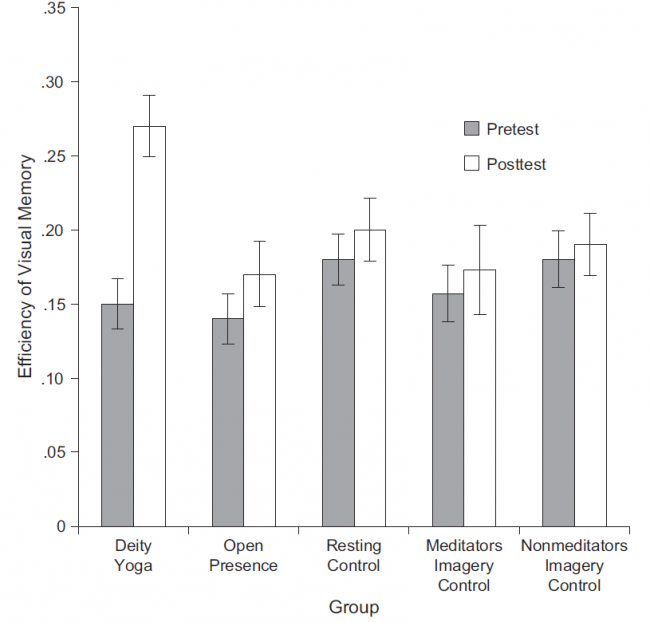
|
| Fig. 3. Processing efficiency on the mental rotation pre- and posttests as a function of group. Error bars show ±1 SEM. | Fig. 4. Processing efficiency on the visual memory pre- and posttests as a function of group. Error bars show ±1 SEM. |
DISCUSSION
The results of this study indicate that there is no baseline difference in imagery skills between meditators and nonmeditators, or between long-term practitioners of different styles of meditation. However, DY practitioners demonstrated a dramatic increase in performance on both image-maintenance and spatial tasks in the posttest (after they had meditated), in contrast to the other four groups. Therefore, DY specifically trains one’s capacity to access heightened visuospatial memory resources via meditation, rather than generally improving long-lasting imagery abilities.
The finding that DY meditators have access to a state of heightened visuospatial resources has many implications for therapy, treatment of memory loss, and mental training. It points out that latent resources of the brain can be accessed and consciously activated. It also raises questions regarding the mechanisms involved in achieving this state. As mentioned in the introduction, the observed effect might be due to the involvement of focused visual attention during DY meditation; such attention is critical in facilitating control over the contents of visuospatial working memory (Awh & Jonides, 2001; Jha, 2002). Support for this explanation comes from the results of neurophysiological studies, which suggest that prefrontal cortex that contributes to visuospatial attentional selection processes has reciprocal connections with most or all of extrastriate visual cortex, and acts as a source of biasing activity in the visual cortex (e.g., Desimone, 1996; Ungerleider, Gaffan, & Pelak, 1989). During DY meditation, the selective focused attention directed to specific visual stimuli might activate prefrontaltemporal and prefrontal-parietal connections, facilitating an enhancement of visuospatial working memory. However, future studies are needed to verify this speculation using neuroimaging techniques.
Furthermore, previous research has found large-scale coherence, either in the gamma spectrum or in the alpha-theta spectra, to be a signature electroencephalogram (EEG) waveform found during meditation (Lutz, Greischar, Rawlings, Ricard, & Davidson, 2004; Travis, Tecce, Arenander, & Wallace, 2002). Thus, our results could possibly be attributed to the occurrence of such synchronies during DY practice. The multimodal nature of DY, involving complex interactions between various systems, might provide the necessary foundations for the activation of heightened imagery capacities, resulting in a state of global coherence between different brain regions. Although similar synchronies might occur during imagery (nonmeditation) tasks, they are probably less pronounced, because of the differences in the duration of the temporal synchronization (i.e., trial by trial for visuospatial tasks vs. throughout a meditation session). This speculation could be investigated by comparing DY with meditation on less sophisticated visual stimuli, such as different colors or objects, which have less visual and emotional complexity than the image of a deity during DY meditation.
We are not certain how long this state of access to heightened visuospatial resources might last. Informal interviews with practitioners suggest that the duration may depend on the predisposition of the individual practitioner and his or her level of expertise. The ‘‘power of the experience of becoming a deity,’’ according to practitioners’ reports, contributes to the resilience of the image’s integrity, and the ease of its manipulation. During the informal interviews, some of the practitioners reported that the powerful state of identification with the deity can be sustained for several hours or more, whereas others reported that the effect lasted for only approximately 20 to 25 min. Similarly, the speed of accessing this state varies: According to self-reports by most practitioners who participated in our study, 20 min was ample time, but several reported that more time allotted to meditation would have been beneficial for their achieving a deity state, so that they could ‘‘develop more power.’’ Therefore, accessing and maintaining this state seem to depend on the particular expertise and meditation strength of the practitioner.
The inspiration behind this study stemmed from debate between Buddhist monks and scientists concerning Buddhist monks’ reports of having enhanced imagery abilities. Indeed, the monks do have access to states of heightened imagery capacity, but, as the scientists stated, these states are not sustained constantly. According to the reports of the meditators in our study, these states can last no longer than several hours; moreover, the meditators had to engage in a preparatory period of meditation before these states could be accessed.
This emergence of heightened capacity as a particular mental state, and the process by which it is achieved, may be compared to processes in athletic training. While engaging in intense physical activity, athletes often report entering a state similar to that achieved by DY meditators, often termed ‘‘the zone.’’ In this state, athletes’ physical abilities exceed their normal capacities: The athletes exhibit enhanced speed in decision making, heightened attentional capabilities, and decreased fatigue (Csikszentmihalyi, 1990, 1996). It is possible that the effects of meditation and ‘‘the zone’’ are similar in some respects, although the effects of meditation are related to heightened mental capacities, rather than heightened physical capacities. Further investigation of the relationship between these two phenomena would be required to evaluate this claim, and the results of such a study could have useful implications in developing training procedures that will produce effective access to latent physical and mental resources.
Acknowledgments—Part of this research was done by Maria Kozhevnikov during her sabbatical leave in Shechen Monastery in Nepal. We thank Ros’Ana Reis, Konchog Lhadripa, and Matthieu Ricard for their help at the Shechen Monastery. We also thank Stephen Kosslyn and Raja Parasuraman for fruitful discussions, as well as Patrick McKnight for statistical advice.
REFERENCES
- Awh, E., & Jonides, J. (2001). Overlapping mechanisms of attention and spatial working memory. Trends in Cognitive Sciences, 5, 119– 126.
- Barinaga, M. (2003). Studying the well-trained mind. Science, 302, 44– 46.
- Becker, D.E., & Shapiro, D. (1980). Directing attention toward stimuli affects P300 but not the orienting response. Psychophysiology, 17, 385–389.
- Beyer, S. (1978). The cult of Tara. Berkeley: University of California Press.
- Brefczynski-Lewis, J.A., Lutz, A., Schaefer, H.S., Levinson, D.B., & Davidson, R.J. (2007). Neural correlates of attentional expertise in long-term meditation practitioners. Proceedings of the National Academy of Sciences, USA, 104, 11483–11488.
- Corbetta, M., Kincade, J.M., & Shulman, G.L. (2002). Neural systems for visual orienting and their relationships to spatial working memory. Journal of Cognitive Neuroscience, 14, 508–523.
- Csikszentmihalyi, M. (1990). Flow: The psychology of optimal experience. New York: Harper Collins.
- Csikszentmihalyi, M. (1996). Creativity: Flow and the psychology of discovery and invention. New York: Harper Collins.
- Dalai Lama, Tsong-ka-pa, & Hopkins, J. (1987). Tantra in Tibet. Valois, NY: Snow Lion.
- Desimone, R. (1996). Neural mechanisms for visual memory and their role in attention. Proceedings of the National Academy of Sciences, USA, 93, 13494–13499.
- Feng, J., Spencer, I., & Pratt, J. (2007). Playing an action video game reduces gender differences in spatial cognition. Psychological Science, 18, 850–855.
- Giorgi, A. (1970). Psychology as a human science: A phenomenologically based approach. New York: Harper and Row.
- Goleman, D. (1977). The meditative mind. New York: Perigee Books. Guenther, H.V. (1993). Ecstatic spontaneity: Saraha’s three cycles of Doha. Freemont, CA: Asian Humanities Press.
- Gyatrul, R. (1996). Generating the deity. Ithaca, NY: Snow Lion. Jha, A. (2002). Tracking the time-course of attentional involvement in spatial working memory: An event-related potential investigation. Cognitive Brain Research, 15, 61–69.
- Jha, A., Klein, R., Krompinger, J., & Baime, M. (2007). Mindfulness training modifies subsystems of attention. Cognitive, Affective, and Behavioral Neuroscience, 7, 109–119.
- Kosslyn, S.M. (1994). Image and brain: The resolution of the imagery debate. Cambridge, MA: MIT Press.
- Kozhevnikov, M., Kosslyn, S., & Shephard, J. (2005). Spatial versus object visualizers: A new characterization of visual cognitive style. Memory & Cognition, 33, 710–726.
- Kozhevnikov, M., Motes, M., Rasch, B., & Blajenkova, O. (2006). Perspective-taking vs. mental rotation transformations and how they predict spatial navigation performance. Applied Cognitive Psychology, 20, 397–417.
- Kozhevnikov, M., & Thornton, R. (2006). Real-time data display, spatial visualization ability, and learning force and motion concepts. Journal of Science Education and Technology, 15, 113– 134.
- Lohman, D.F., & Nichols, P.D. (1990). Training spatial abilities: Effects of practice on rotation and synthesis tasks. Learning and Individual Differences, 2, 67–93.
- Luciana, M., Deue, R., Arbisi, P., & Leon, A. (1992). Facilitation of working memory in humans by a D2 dopamine receptor agonist. Journal of Cognitive Neuroscience, 41, 58–68.
- Lutz, A., Dunne, J., & Davidson, R. (2007). Meditation and the neuroscience of consciousness. In P.D. Zelazo, M. Moscovitch, & E. Thompson (Eds.), The Cambridge handbook of consciousness (pp. 499–551). Cambridge, England: Cambridge University Press.
- Lutz, A., Greischar, L., Rawlings, N.B., Ricard, M., & Davidson, R.J. (2004). Long-term meditators self-induce high-amplitude gamma synchrony during mental practice. Proceedings of the National Academy of Sciences, USA, 101, 16369–16373.
- Lutz, A., Slagter, H.A., Dunne, J.D., & Davidson, R.J. (2008). Attention regulation and monitoring in meditation. Trends in Cognitive Sciences, 12, 163–169.
- MMVirtual Design, LLC. (2004). Imagery testing battery [Computer software]. Newark, NJ: Author.
- Newberg, A., Alavi, A., Baime, M., Pourdehnad, M., Santanna, J., & d’Aquili, E. (2001). The measurement of regional cerebral blood flow during the complex cognitive task of meditation: A preliminary SPECT study. Psychiatry Research, 106, 113–122.
- Rabjam, L. (2001). A treasure trove of scriptural transmission: A commentary on the precious treasury of the basic space of phenomena. Junction City, CA: Padma.
- Sayala, S., Sala, J.B., & Courtney, S.M. (2005). Increased neural efficiency with repeated performance of a working memory task is information-type dependent. Cerebral Cortex, 16, 609–617.
- Shepard, R.N., & Metzler, J. (1971). Mental rotation of three-dimensional objects. Science, 171, 701–703.
- Snellgrove, D. (2003). Indo-Tibetan Buddhism: Indian Buddhists and their Tibetan successors. Boston: Shambala.
- Travis, F., Tecce, J., Arenander, A., &Wallace, R.K. (2002). Patterns of EEG coherence, power, and contingent negative variation characterize the integration of transcendental and waking states. Biological Psychology, 61, 293–319.
- Trungpa, C. (2000). Journey without goal: Tantric wisdom of the Buddha. Boston: Shambala.
- Ungerleider, L.G., Gaffan, D., & Pelak, V.S. (1989). Projections from inferior temporal cortex via the uncinate fascicle in rhesus monkeys. Experimental Brain Research, 76, 473–484.
- Wangyal, T. (1993). Wonders of the natural mind: The Essence of Dzogchen in the native Bon tradition. Ithaca, NY: Snow Lion.
Footnotes
- ↑ Open Presence is a contemporary translation of the Tibetan term Rig-pa (Lutz, Dunne, & Davidson, 2007), which is used to indicate both the state of pure awareness and specific meditation practices leading to this state. We use the term to indicate the practices.
- ↑ At the final stages of DY, an image of a deity dissolves into emptiness (Gyatrul, 1996).We specifically asked our DYparticipants to maintain an image of a deity for all 20 min, without its resolution into emptiness.
- ↑ These older males became fatigued, and their RTs became increasingly long over the posttest until they finally opted not to continue (outliers and unattempted trials: ≈10% of all trials).
Source
Maria Kozhevnikov, Olga Louchakova, Zoran Josipovic, and Michael A. Motes
George Mason University, Institute of Transpersonal Psychology at Palo Alto, New York University, and University of Texas at Dallas
nmr.mgh.harvard.edu/mkozhevnlab
